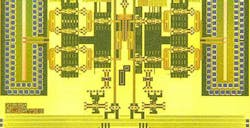Millimeter-wave frequencies have received their fair share of attention recently, largely due to their use in communications links as part of coming 5G wireless communications networks. But millimeter-wave frequencies have been in used in military systems for some time, in such applications as communications, electronic warfare (EW), and radar systems.
DARPA is driving the development of compact integrated circuits (ICs) capable of operating beyond 100 GHz in support of these applications. Although semiconductor technologies such as GaAs and GaN have long been the basis for high-frequency ICs, DARPA’s Efficient Linearized All-Silicon Transmitter ICs (ELASTx) program is chasing after millimeter-wave ICs—ones fabricated not on GaAs or GaN, but on low-cost silicon.
In addition to being lower in cost than GaAs and GaN semiconductor wafers, RF/microwave circuits on silicon ICs can readily be integrated with digital circuit functions to form mixed-signal solutions. The challenge has long been achieving low-loss circuits on silicon. To meet that challenge, researchers working on the ELASTx program recently announced an all-silicon system-on-a-chip (SoC) transmitter (see photo) capable of operating at 94 GHz.
This all-silicon SoC is a 94-GHz transmitter with integral PA and digital compensation circuitry developed as part of the ELASTx program. (Photo courtesy of DARPA)
“What normally would require multiple circuit boards, separate metal shielded assemblies, and numerous I/O cables, we can now miniaturize onto one silicon chip about half the size of an adult’s thumbnail,” said DARPA Program Manager Dev Palmer. “This accomplishment opens the door for co-designing digital CMOS and millimeter-wave capabilities as an integrated system on an all-silicon chip, which should make possible new design architectures for future military RF systems.”
The silicon SoC transmitter has a digitally assisted power amplifier (PA) for dynamic correction of amplifier performance under changing conditions. The digital correction enables simultaneous optimization of normally conflicting performance parameters, such as efficiency and linearity. Palmer observes: “This SoC can support a range of modulation formats, so it’s possible to communicate to multiple systems using different waveforms from a single silicon chip. Its efficient silicon construction will significantly reduce size, weight, and power (SWaP) requirements for millimeter-wave applications, including compact satellite communications ground terminals for frontline troops. These new capabilities will provide connectivity to more service members faster and at lower cost.”
DARPA’s all-silicon SoC is being developed by Northrop Grumman Aerospace Systems. The ELASTx program consists of three phases with aggressive, increasing-frequency, and bandwidth goals for each phase. In the first phase, the target is a bandwidth of 3.5 GHz centered at 45 GHz. In the second phase, the bandwidth is 5 GHz at a carrier frequency of 94 GHz. In the third phase, the goal is a bandwidth of 8 GHz at 138 GHz. With this 94-GHz transmitter IC having been developed, 138 GHz lies ahead.


